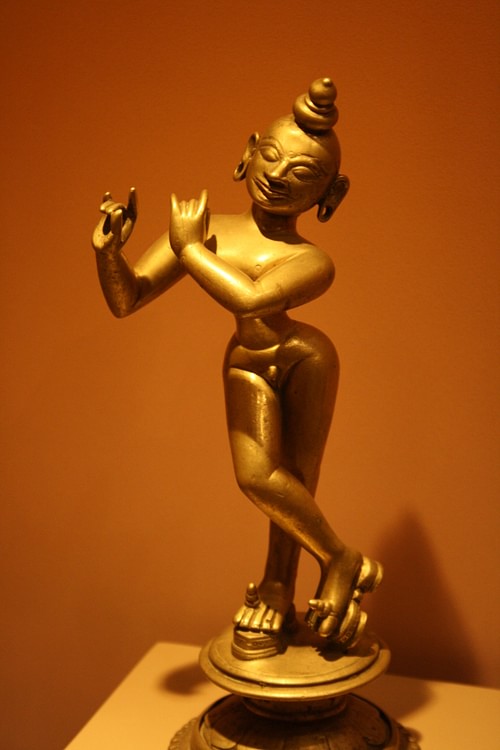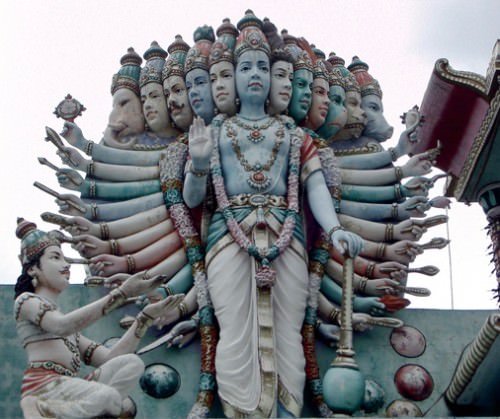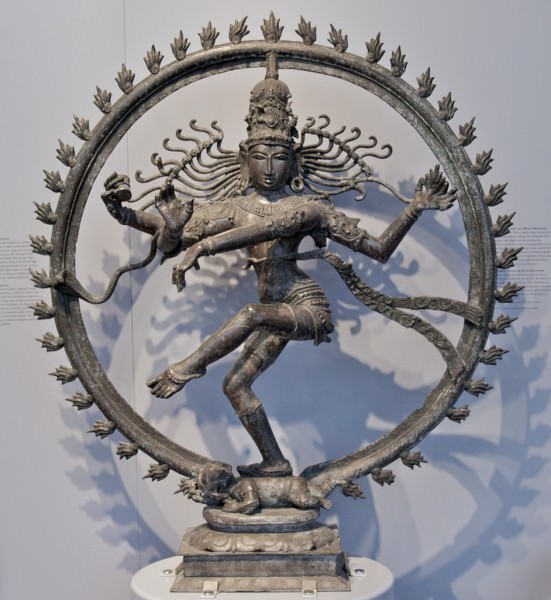Krishna › Shiva » Ancient origins
Articles and Definitions › Contents
- Krishna › Who Was
- Shiva › Who Was
Ancient civilizations › Historical and archaeological sites
Krishna › Who Was
Definition and Origins

Krishna (also Krsna or Hari Krishna) is a major Hindu god and considered the eighth incarnation of Vishnu. He is perhaps the most popular of all the heroes of Hindu mythology. Krishna's adventures are recounted in the Mahabharata, the Bhagavad Gita, the Harivamsa, and the sacred collection of texts known as the Puranas where Krishna is described as the Supreme Being and creator of the universe. The most ancient tales of Krishna involve his adventures with the Pandava princes whilst later, stories accumulated over the centuries which describe his eventful youth, when Krishna used his proficient weapons skills to good effect to defeat a host of fearsome enemies, demons and monsters.
FAMILY & ADVENTUROUS YOUTH
According to tradition Krishna belonged to the Yadava - a pastoral race - and the god's birth is picturesquely described in the Mahabharata. One day Vishnu, the great Hindu god pulled two hairs from his own head, one white and one black. The black hair was planted into the womb of Devaki, a princess of the city of Mathura, and so Krishna was born into the Pandava family, his earthly father being Vasudeva. Unfortunately for Krishna his mother's brother, Kamsa, had been warned that Devaki's eighth child would kill him, and so Kamsa determined to murder the eighth child, a crime he had already carried out seven times before Krishna was born. Fortunately, Vasudeva took the precaution of hiding Krishna in the remote village of Vrindavana where the boy was brought up as a simple cowherd (in this guise he can be referred to as Govinda). There he spent an idyllic childhood and stirred the hearts of many gopis or herd-women with his dark good looks, playful charm, and mastery of music and dance.
KRISHNA'S DUAL ROLE IS AS THE PUNISHER OF HUMAN DEEDS BUT ALSO AS A BRINGER OF ENLIGHTENMENT.
Thus the story of Krishna contains a double concealment - Krishna is both a god disguised as a mortal and a prince disguised as a commoner. Accordingly, the myths contain many metaphors of disguise, such as a spark within a pile of ashes or a mighty sword in its scabbard, and these hint at Krishna's dual purpose as the punisher of human deeds but also as a bringer of enlightenment.
Krishna's foster parents at Vrindavana were Nanda and Yashoda, his sister is Subhadra, and his brother Balarama. Krishna's favourite wife was Radha, with whom he had a son Pradyumna and daughter Carumati, but tradition has it that the god actually acquired 16,108 wives and fathered 180,000 sons. Queen Rukmini, an earthly form of the goddess Lakshmi, is considered Krishna's second most favoured wife after Radha.
Krishna was involved in many escapades in his adventurous youth. Notable amongst these are his various killings and thrashings of prominent enemies such as the ogress Putana, the giant bull danava, the giant snake Kaliya, and the king of the Hayas (horses). Also swiftly dealt with was the scheming tyrant Kamsa – after whose beheading Krishna established himself as king of Mathura. Krishna slew many demons: Muru and his 7,000 sons, Pralamba – who Krishna beat up using only his fists, Naraka – son of the Earth and who had accumulated a harem of 16,000 captured women, and the sea-demon Pancajana who looked like a conch shell and who lost his magic shell to Krishna which the hero carried thereafter and used as a trumpet.Krishna also found time to lift the mountain Govardhana to foil a terrible deluge sent by Indra, to conquer Saubha, the floating city of the Titans ( daityas ), got the better of the sea-god Varuna, and even managed to steal the divine discuss possessed by the fire-god Agni. Against mere mortals Krishna also wreaked havoc amongst the Gandharas, Bhojas, and Kalingas, amongst others.

Krishna manifesting his full glory to Arjuna
KRISHNA & ARJUNA
Krishna acted as the warrior-prince Arjuna's charioteer in the Great War, the Battle of Kurukshetra, between the Pandavas(whom Krishna supported) and the Kauravas. It was on the eve of this battle that Krishna recounted the sacred song of the Bhagavad Gita to Arjuna. Within, Lord Krishna highlights that the self is quite separate from the body and continues throughout time: 'Never was there a time I did not exist, nor you, nor all these kings; nor in the future, shall any of us cease to exist' ( Bhagavad Gita ). It is in the Bhagavad Gita that Krishna also states that 'All this universe has been created by me; all things exist in me'. Arjuna, in the same work, tells us that Krishna is 'divine, prior to the gods, unborn, omnipresent'.
In other adventures Krishna built the great fortress city of Dvaraka in Gujarat, known as the 'City of Gates'. Seven days after Krishna was accidentally killed by a hunter's arrow striking his heel, Dvaraka was submerged beneath the ocean. Krishna had also stolen the sacred Parijata tree from Indra, defeating the god in the process. Krishna planted the tree at Dvaraka, but upon his death it was returned to Indra.

Krishna & Radha
WORSHIP & REPRESENTATION IN ART
The worship of Krishna may have started as early as the 5th century BCE. Today he is worshipped as the supreme Hindu god by many believers, and he is especially revered in Bengal and Udupi in southern India. One of the many festivals held in his honour is the ratha-yatra chariot festival in Puri which commemorates Radha's successful attempt to persuade Krishna to return to Vrindavana. Perhaps the most widely observed festival is the Krishna Janmashtami (mid-August to early September) which involves devotees fasting for 24 hours, offering milk sweets to the baby Krishna, and, at midnight, lighting wicks soaked in ghee (purified butter) in the ritual known as arati.
Krishna is typically portrayed in Hindu art with a dark skin (usually blue-black), and he may carry the cakra discus Vajranabha and the club Kaumodaki – both given to him by Agni. He typically wears a yellow robe, has a peacock feather in his long black hair, and commonly plays a flute. In reference to his occupation as a cowherd in his youth, Krishna is often accompanied with cows. In Khmer art the most popular scene of Krishna's adventures is the lifting of Mt. Govardhana, and the god is frequently represented in the architectural sculpture at such famous sites as Angkor Wat.
Shiva › Who Was
Definition and Origins

Shiva (or Siva) is one of the most important gods in the Hindu pantheon and, along with Brahma and Vishnu, is considered a member of the holy trinity ( trimurti ) of Hinduism. A complex character, he may represent goodness, benevolence and serve as the Protector but he also has a darker side as the leader of evil spirits, ghosts and vampires and as the master of thieves, villains and beggars. He is also associated with Time, and particularly as the destroyer of all things. Nevertheless, Shiva is also associated with creation. In Hinduism, the universe is thought to regenerate in cycles (every 2,160,000,000 years). Shiva destroys the universe at the end of each cycle which then allows for a new Creation. Shiva is also the great ascetic, abstaining from all forms of indulgence and pleasure, concentrating rather on meditation as a means to find perfect happiness. He is the most important Hindu god for the Shaivism sect, the patron of Yogis and Brahmins, and also the protector of the Vedas, the sacred texts.
SHIVA, PARVATI & GANESHA
Shiva's wife was Parvati, often incarnated as Kali and Durga. She was in fact a reincarnation of Sati (or Dakshayani), the daughter of the god Daksha. Daksha did not approve of Sati's marriage to Shiva and even went further and held a special sacrificial ceremony to all the gods except Shiva. Outraged at this slight, Sati threw herself on the sacrificial fire. Shiva reacted to this tragedy by creating two demons (Virabhadra and Rudrakali) from his hair who wreaked havoc on the ceremony and beheaded Daksha. The other gods appealed to Shiva to end the violence and, complying, he brought Daksha back to life but with the head of a ram (or goat). Sati was eventually reincarnated as Parvati in her next life and she re-married Shiva.
SHIVA IS THE DESTROYER WHO ENDS THE CYCLE OF TIME WHICH, IN TURN, BEGINS A NEW CREATION.
With Parvati, Shiva had a son, the god Ganesha. The boy was in fact created out of earth and clay to keep her company and protect her while Shiva went on his meditative wanderings. However, Shiva returned one day and, finding the boy guarding the room where Parvati was bathing, he enquired who he was. Not believing the boy was his son, and thinking him an impudent beggar, Shiva called up the bhutaganas demons who fought the boy and eventually managed to distract him with the appearance of the beautiful Maya and, whilst he admired the beauty, they lopped off his head. At the commotion, Parvati rushed from her bath and screamed that her son had been killed. Realising his error, Shiva then sent for a new head with which to make the boy whole again but the nearest at hand was of an elephant. And so Ganesha, the elephant-headed god, was born. Other sons of Shiva are Skanda or Karttikeya, the god of war and Kuvera, the god of treasures.

Shiva Nataraja (Lord of the Dance)
Ganga (the goddess who personified the river Ganges ) was given to Shiva by Vishnu who could not take any more of the constant quarrels between his then three wives of Lakshmi (goddess of good fortune), Saraswati (goddess of wisdom) and Ganga. To cushion Ganga's fall to the earth, and prevent such a great river destroying civilisation, Shiva caught her in his hair topknot; once again, illustrating his quality of self-sacrifice.
SHIVA NATARAJA IS THE LORD OF THE DANCE WHO SWEEPS AWAY ILLUSION & IGNORANCE.
SHIVA IN MYTHOLOGY
As with any major god, Shiva was involved in many adventurous episodes which illustrate his virtuous character and offer instruction on how to live correctly. For example, self-sacrifice is emphasised when Vasuki, the king of Serpents, threatened to vomit snake venom across the seas. Shiva, assuming the form of a giant tortoise or turtle, collected the venom in his palm and drank it. The poison burned his throat and left a permanent blue scar, hence one of his many titles became Nilakantha or Blue Throat.
Another celebrated episode describes how Shiva became associated with the bull Nandi. One day, Surabhi, who was the original mother of all the world's cows, began to give birth to an untold number of perfectly white cows. The milk from all these cows flooded the home of Shiva, somewhere in the Himalaya. Angry at this disturbance to his meditation, the god struck the cows with fire from his third eye. In consequence, patches of the cows' hides were turned brown. Still angry, the other gods sought to calm Shiva down by offering him a magnificent bull - Nandi, the son of Surabhi and Kasyapa - which Shiva accepted and rode. Nandi also became the protector of all animals.
Shiva is closely associated with the Linga (or Lingham) - a phallus or symbol of fertility or divine energy found in temples to the god. Following the death of Sarti, and before her reincarnation, Shiva was in mourning and went to the Daru forest to live with rishis or sages. However, the wives of the rishis soon began to take an interest in Shiva. In jealousy, the rishis first sent a large antelope and then a gigantic tiger against the god but Shiva swiftly dealt with them and wore the tiger skin thereafter. The sages then cursed Shiva's manhood which, in consequence, fell off. When the phallus struck the ground, earthquakes began and the ricsis became afraid and asked for forgiveness. This was given but Shiva told them to forever after worship the phallus as the symbolic Linga.

Shiva, Vietnam
SHIVA IN ART
In Asian art Shiva may be represented in slightly different ways depending on the particular culture: Indian, Cambodian, Javanese etc. but he is most commonly depicted naked, with multiple arms and with his hair tied up in a topknot. He often has three horizontal stripes and a third vertical eye on his forehead. He wears a headdress with a crescent moon and a skull (representing the fifth head of Brahma, which he decapitated as punishment for the god lusting after his own daughter Sandhya), a necklace of heads, and snakes as bracelets. In this guise, he usually represents Nataraja and dances the Tandava within a circle of fire which represents the never-ending cycle of time. He holds the divine fire ( agni ) which destroys the universe and the drum ( damaru ) which makes the first sounds of the creation. One hand makes the calming abhayamudra gesture and another points to his left foot, symbol of salvation. He also stamps one foot on the dwarf figure Apasmara Purusha who represents illusion and who leads men away from the truth.
Shiva may also be depicted standing on one leg with the right leg folded in front of the left knee and holding a rosary in his right hand, the typical posture of ascetic meditation. Sometimes he also rides his white bull, carries a silver bow ( Pinaka ), holds an antelope, and wears a tiger or elephant skin, all symbolic of his famed prowess as a hunter.
Shiva may also be depicted standing on one leg with the right leg folded in front of the left knee and holding a rosary in his right hand, the typical posture of ascetic meditation. Sometimes he also rides his white bull, carries a silver bow ( Pinaka ), holds an antelope, and wears a tiger or elephant skin, all symbolic of his famed prowess as a hunter.
LICENSE:
Article based on information obtained from these sources:with permission from the Website Ancient History Encyclopedia
Content is available under License Creative Commons: Attribution-NonCommercial-ShareAlike 3.0 Unported. CC-BY-NC-SA License